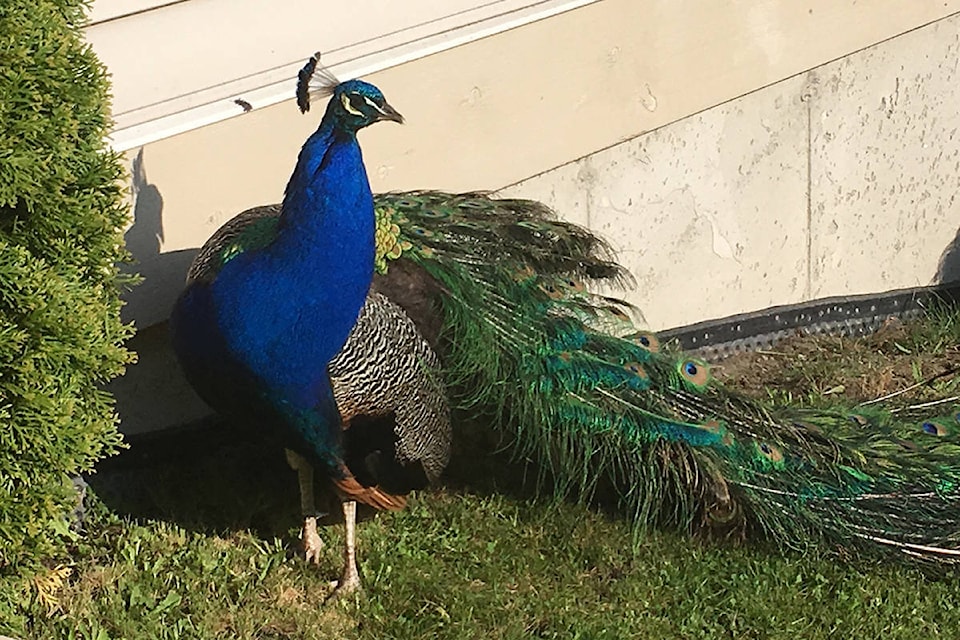The City of Surrey in June approved a relocation plan that includes trapping and relocating an estimated 100 peacocks in Sullivan Heights, but that trapping has yet to commence.
“Since the end of July, we’ve really warmed up our phased approach,” said Jas Rehal, Surrey’s manager of public safety operations.
“First, we needed to eliminate the feed source, to ensure the trapping program is successful. Previously people were pulling into side streets, taking pictures and feeding the peacocks. That’s been limited. There’s next to none now.”
Complaints about the peacocks in that neighbourhood go back to 2010 after a previous homeowner left them behind in 2006.
Over the years, some in the community have developed a fondness for the birds, while others find them to be a nuisance. In recent months there have been reports of the birds attacking cars.
Things came to a boiling point on April 30, when a frustrated homeowner was fined $1,000 after cutting down a tree known to be a home to the peacocks, saying the city’s inaction left him no choice.
The situation got even more dramatic when the city said a bylaw officer was allegedly assaulted over a peacock complaint in early June.
RCMP confirmed they were investigating the incident, in the 6200-block of 150th Street on June 4, which is alleged to have happened when a bylaw officer was following up on a complaint that someone had been feeding peacocks.
See also: Surrey bylaw officer assaulted over peacock complaint, city says
See also: Surrey man says he illegally cut peacock tree out of desperation
See also: Surrey looks to Florida, Hawaii to solve peacock problem
The city’s recently approved plan means residents who feed or house the birds will now face stiff fines: Anyone found in violation can be slapped with a $250 fine, and anyone found to be keeping a peafowl could face a fine of $450 per bird, and the bird would be seized.
The city has also recently installed signage, alerting residents and visitors alike of new rules.
Removing that food source for the birds has made a noticeable difference in the area, according to Rehal.
“The peafowl have gone higher up now, they’re not on six or seven homes like they used to be,” he said. “And I mean higher up in height, in the trees. Before, because there was so much feed source around they were hanging around fences, sidewalks, they were roaming around. Before, you’d see a handful of peacocks at any given time. Now, you have to actually look for them.”
That’s been achieved, according to Rehal, by the increased bylaw presence in the area and now, the relocation plan is set to launch in early September.
The city’s plan — which involves capturing and moving the birds to Surrey Animal Resource Centre, then adopting them out from there — was approved by council in late June.
A certified biologist is to be hired to oversee the action plan, and “humane traps” will also be provided to owners, upon request.
“While the community continues to be divided on the issue of peafowl, staff recognize the negative impacts to safety and property caused by the nuisance peafowl,” Rehal wrote in June.
“Staff appreciate some residents want them to remain as an aesthetic value, but a residential area is not an appropriate place for peafowl. Tensions continue to rise in the area, and staff receive a high amount of daily calls, emails and complaints.
“The primary issues raised by residents have been related to noise, excrement, damage to property and aggressive behaviour towards domestic pets and children.”
Other communities with peacock problems have struggled to resolve them.
Longboat Key, Florida began a peafowl removal program in January 2016. In a report, Surrey staff wrote those efforts were “incomplete.”
“The population (while much smaller) is growing again,” the reported noted. “They have used both contract trappers and staff to manage their efforts.”
Ranchos Palos Verdes, California began a peafowl removal process in August 2015 and currently have “small pockets of remaining peafowl in several neighbourhoods that are removed on a complaint basis by the Los Angeles Zoo,” Surrey staff note, adding, “they have intensively resourced the issue through their Code Enforcement Department with additional staff and by working collaboratively with the Los Angeles Zoo.”
Australia, meantime, is developing a national strategy to address feral peafowl populations which may be adopted this summer, Rehal notes.
“(Australia’s) strategy includes a variety of potential resolutions that can be applied in individual locations – for example: stabilizing the population by removing all reproductive peafowl, culling the entire population or leaving the peafowl as is.”
